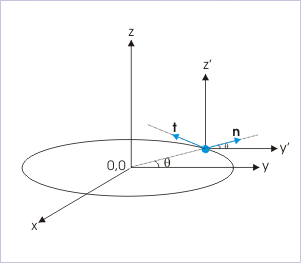| << Chapter < Page | Chapter >> Page > |
Normal (radial) acceleration acts in the direction perpendicular to tangential direction. We have seen that the normal acceleration, known as centripetal acceleration in the case of uniform circular motion, is given by :
where “r” is the radius of the circular path. We can extend the expression of centripetal acceleration to all such trajectories of two dimensional motion, which involve radius of curvature. It is so because, radius of the circle is the radius of curvature of the circular path of motion.
In the case of tangential acceleration, we have argued that the motion should involve a change in the magnitude of velocity. Is there any such inference about normal (radial) acceleration? If motion is along a straight line without any change of direction, then there is no normal or radial acceleration involved. The radial acceleration comes into being only when motion involves a change in direction. We can, therefore, say that two components of accelerations are linked with two elements of velocity (magnitude and direction). A time rate of change in magnitude represents tangential acceleration, whereas a time rate of change of direction represents radial (normal) acceleration.
The above deduction has important implication for uniform circular motion. The uniform circular motion is characterized by constant speed, but continuously changing velocity. The velocity changes exclusively due to change in direction. Clearly, tangential acceleration is zero and radial acceleration is finite and acting towards the center of rotation.
Total acceleration is defined in terms of velocity as :
In terms of component accelerations, we can write total accelerations in the following manner :
The magnitude of total acceleration is given as :
where
In the nutshell, we see that time rate of change in the speed represents a component of acceleration in tangential direction. On the other hand, magnitude of time rate of change in velocity represents the magnitude of total acceleration. Vector difference of total and tangential acceleration is equal to normal acceleration in general. In case of circular motion or motion with curvature, radial acceleration is normal acceleration.
We consider motion of a particle along a circular path. As pointed out in the section above, the acceleration is given as vector sum of two acceleration components as :
Two dimensional circular motion

where “ t ” and “ n ” are unit vectors in the tangential and radial directions. Note that normal direction is same as radial direction. For the motion shown in the figure, the unit vector in radial direction is :
Unit vectors

Similarly, the unit vector in tangential direction is :

Notification Switch
Would you like to follow the 'Physics for k-12' conversation and receive update notifications?